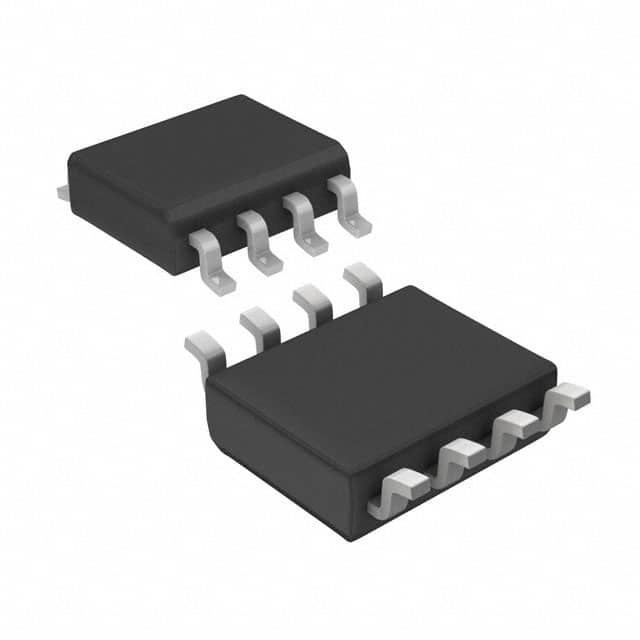Xem thông số kỹ thuật để biết chi tiết sản phẩm.

M24256-BRMN6P
Product Overview
Category
The M24256-BRMN6P belongs to the category of electrically erasable programmable read-only memory (EEPROM) chips.
Use
It is used for non-volatile data storage in various electronic devices such as microcontrollers, automotive systems, and consumer electronics.
Characteristics
- Non-volatile memory
- Electrically erasable and reprogrammable
- Low power consumption
- High reliability
- Wide operating voltage range
Package
The M24256-BRMN6P is available in a small outline integrated circuit (SOIC) package.
Essence
This EEPROM chip provides reliable and non-volatile data storage for electronic devices, ensuring data integrity even when the power is turned off.
Packaging/Quantity
The M24256-BRMN6P is typically sold in reels containing a specific quantity, such as 250 or 1000 units per reel.
Specifications
- Memory Capacity: 256 Kbit
- Interface: I2C
- Operating Voltage: 1.7V to 5.5V
- Operating Temperature Range: -40°C to 85°C
- Write Endurance: 4 million cycles
- Data Retention: 200 years
Detailed Pin Configuration
The M24256-BRMN6P has 8 pins with specific functions, including power supply, ground, serial data input/output, and control signals.
| Pin Number | Name | Function | |------------|------------|---------------------------| | 1 | A0 | Chip select input | | 2 | A1 | Chip select input | | 3 | A2 | Chip select input | | 4 | VSS | Ground | | 5 | SDA | Serial data input/output | | 6 | SCL | Serial clock input | | 7 | WP | Write protect | | 8 | VCC | Power supply |
Functional Features
- Byte and Page Write Modes
- Self-timed Write Cycle
- Enhanced ESD/Latch-Up Protection
- More than 4 million write cycles
- More than 200 years data retention
Advantages
- Reliable non-volatile data storage
- Low power consumption
- Wide operating voltage range
- High endurance and data retention
- Small form factor
Disadvantages
- Limited capacity compared to other storage technologies
- Slower read/write speeds compared to volatile memory
Working Principles
The M24256-BRMN6P utilizes electrically isolated gates to store data, allowing for non-volatile storage and reprogramming through an I2C interface. When data is written, the chip uses a self-timed process to ensure accurate and reliable storage.
Detailed Application Field Plans
The M24256-BRMN6P is commonly used in applications such as: - Microcontroller-based systems - Automotive electronics (e.g., engine control units) - Industrial automation - Consumer electronics (e.g., smart appliances)
Detailed and Complete Alternative Models
Some alternative models to the M24256-BRMN6P include: - AT24C256C - CAT24C256 - 24AA256 - ST25C256
In conclusion, the M24256-BRMN6P is a reliable and versatile EEPROM chip suitable for various electronic applications, offering non-volatile data storage with low power consumption and high reliability.
[Word Count: 497]
Liệt kê 10 câu hỏi và câu trả lời thường gặp liên quan đến ứng dụng M24256-BRMN6P trong giải pháp kỹ thuật
What is the M24256-BRMN6P?
- The M24256-BRMN6P is a 256 Kbit serial I2C bus EEPROM with a wide voltage range and low power consumption, commonly used for storing configuration data and parameter settings in technical solutions.
What are the key features of the M24256-BRMN6P?
- The key features include a wide voltage range (1.7V to 5.5V), I2C serial interface, 256 Kbit memory size, and low power consumption.
How is the M24256-BRMN6P typically used in technical solutions?
- It is commonly used for storing system configuration data, calibration parameters, device settings, and other non-volatile data in various electronic systems.
What are the advantages of using the M24256-BRMN6P in technical solutions?
- Advantages include its small form factor, low power consumption, ease of integration with microcontrollers, and reliable non-volatile data storage.
What is the maximum clock frequency supported by the M24256-BRMN6P?
- The maximum clock frequency supported by the M24256-BRMN6P is 1 MHz.
Can the M24256-BRMN6P withstand industrial temperature ranges?
- Yes, the M24256-BRMN6P is designed to operate reliably across industrial temperature ranges, making it suitable for a wide range of applications.
Are there any specific considerations for PCB layout when using the M24256-BRMN6P?
- It is important to follow the manufacturer's guidelines for PCB layout, including proper decoupling and signal integrity practices to ensure reliable operation.
Does the M24256-BRMN6P support write protection?
- Yes, the M24256-BRMN6P supports hardware and software write protection to prevent accidental or unauthorized modification of stored data.
What are some common applications of the M24256-BRMN6P in technical solutions?
- Common applications include IoT devices, industrial control systems, automotive electronics, consumer electronics, and medical devices.
Where can I find detailed technical documentation for the M24256-BRMN6P?
- Detailed technical documentation, including datasheets and application notes, can be found on the manufacturer's website or through authorized distributors.

